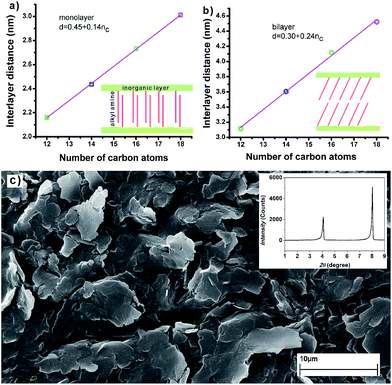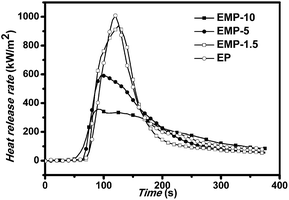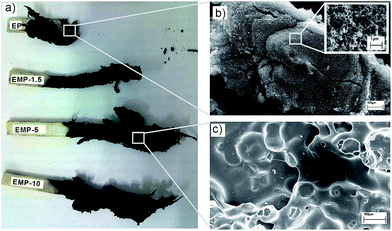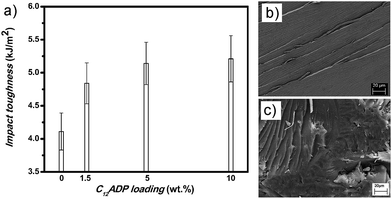Simultaneously enhancing the flame retardancy and toughness of epoxy by lamellar dodecyl-ammonium dihydrogen phosphate†
Rong-Chuan Zhuangac,
Juan Yanga,
De-Yi Wangb and
Ya-Xi Huang*a
aFujian Provincial Key Laboratory of Fire Retardant Materials, Department of Materials Science and Engineering, College of Materials, Xiamen University, Xiamen, 361005, P.R. China. E-mail: yaxihuang@xmu.edu.cn
bIMDEA Materials Institute, C/Eric Kandel 2, Getafe, Madrid 28906, Spain
cXiamen Zijin Mining and Metallurgy Technology Co., Ltd., Xiamen 361101, P.R. China
First published on 13th November 2015
Abstract
Organic/inorganic intercalated dodecyl-ammonium dihydrogen-phosphate (C12ADP) has been prepared by a simple one-pot method. The incorporation of C12ADP into epoxy could improve the flame retardancy and toughness of the obtained C12ADP/EP composites, simultaneously, i.e. improved formed char quality, significantly reduced heat release rate and decreased total heat release, and enhanced impact toughness of EP composites as well.
Epoxy (EP) is being widely used in construction, electronics, aerospace, and many other industrial fields, due to its low curing shrinkage, excellent adhesion to many substrates, resistance to chemical corrosion, electrical insulating property, and great freedom in formulation design.1 However, due to its inherent structure, neat EP is very flammable and brittle, which hinders its application in broader fields and needs to be addressed.2,3
In terms of flame retardancy, halogen-containing flame retardants are highly effective for improving the fire retardancy of EP. However, the obtained flame retarded EPs produce toxic and corrosive gases during combustion, seriously endangering the safety of life and polluting the environment.4,5 Therefore, the application of halogenated flame retardant was already restricted by WEEE and RoHs. As a result of this, exploiting halogen-free fire retardants has attracted growing attention.6–15 Phosphorus-containing flame retardants, as one type of halogen-free alternative flame retardants, have been investigated widely,9–15 whereas, the introduction of phosphorus-containing flame retardant, usually, compromised the mechanical properties, such as impact strength, of EP matrix due to the poor compatibility.14,15 Modification of phosphorus flame retardant with organic moieties, for example microencapsulation, could enhance the compatibility of phosphorus flame retardant with matrix, but the improvement was limited.15 Meanwhile, intensive research studies have shown that the organic/inorganic hybrid layered compounds, such as layered silicates,16,17 metal chelates,18 layered double hydroxide,19,20 and zirconium phosphates,21,22 could toughen EP by introducing long flexible alkyl chain.
Alkyl-ammonium (di)hydrogen phosphates23,24 are layered organic–inorganic intercalation compounds possessing phosphorus, nitrogen, and flexible alkyl chain as well, which suggests that this kind of compounds is potential promising EP modifier acting both as impact toughener and flame retardant. At here, we will describe a simple synthetic protocol of this series of compounds and exploit their application as promising EP modifiers focusing on the impact of dodecyl-ammonium dihydrogenphosphate (C12ADP) on the thermal stability, flame retardancy, and impact toughness of the obtained composites.
Alkyl-ammonium (di)hydrogen phosphates were synthesized via a simple one-pot protocol by mixing and stirring alkyl amine, phosphoric acid and water at room temperature for 48 h. The crystal structure of alkyl-ammonium (di)hydrogen phosphates can be easily tuned by adjusting the molar ratio of alkyl amine to phosphoric acid (cf. small-angle powder XRD patterns of synthesized compounds in Fig. S1†) for all amines used. Generally, mixtures of monolayer and bilayer structures were obtained when the molar ratio of amine to acid equaled to 2![[thin space (1/6-em)]](https://www.rsc.org/images/entities/char_2009.gif) :
:![[thin space (1/6-em)]](https://www.rsc.org/images/entities/char_2009.gif) 1. Once the molar ratio deviated from 2
1. Once the molar ratio deviated from 2![[thin space (1/6-em)]](https://www.rsc.org/images/entities/char_2009.gif) :
:![[thin space (1/6-em)]](https://www.rsc.org/images/entities/char_2009.gif) 1, one can get the pure compounds of bilayer structure or monolayer structure for the molar ratio larger or smaller 2
1, one can get the pure compounds of bilayer structure or monolayer structure for the molar ratio larger or smaller 2![[thin space (1/6-em)]](https://www.rsc.org/images/entities/char_2009.gif) :
:![[thin space (1/6-em)]](https://www.rsc.org/images/entities/char_2009.gif) 1, respectively. The interlayer space, d, of layered compounds were calculated according to the Bragg equation (2d
1, respectively. The interlayer space, d, of layered compounds were calculated according to the Bragg equation (2d![[thin space (1/6-em)]](https://www.rsc.org/images/entities/char_2009.gif) sin
sin![[thin space (1/6-em)]](https://www.rsc.org/images/entities/char_2009.gif) θ = nλ), and plotted as a function of the carbon number of alkyl chain, nC. Fig. 1a and b show the correlation between d and nC, d = 0.30 + 0.24nC and d = 0.45 + 0.14nC (nm) for monolayer structure and bilayer structure by linear regression, respectively, where 0.24 and 0.14 are the slopes. Taken the C–C bond length of 0.154 nm and C–C–C bond angle of 123.9° for alkyl group into consideration,24 the schematic presentations of monolayer and bilayer structure are proposed and shown in Fig. 1a and b, respectively. The alkyl chains of monolayer structure are nearly perpendicular to the inorganic layers, while the alkyl chains of bilayer structure tilt a little bit with respect to inorganic layer.
θ = nλ), and plotted as a function of the carbon number of alkyl chain, nC. Fig. 1a and b show the correlation between d and nC, d = 0.30 + 0.24nC and d = 0.45 + 0.14nC (nm) for monolayer structure and bilayer structure by linear regression, respectively, where 0.24 and 0.14 are the slopes. Taken the C–C bond length of 0.154 nm and C–C–C bond angle of 123.9° for alkyl group into consideration,24 the schematic presentations of monolayer and bilayer structure are proposed and shown in Fig. 1a and b, respectively. The alkyl chains of monolayer structure are nearly perpendicular to the inorganic layers, while the alkyl chains of bilayer structure tilt a little bit with respect to inorganic layer.
C12ADP was used as an example to demonstrate the impact of this series of compounds on the properties of EP composites. The schematic presentation of the synthesis process for C12ADP is shown in Scheme 1. The morphology of C12ADP determined by SEM (Fig. 1c) clearly shows that C12ADP is of layered structure. The small-angle powder X-ray diffraction pattern of C12ADP (see inset of Fig. 1c) is in good agreement with SEM observation and displays two diffraction peaks at 2θ = 4.09° and 2θ = 8.44°, suggesting an interlayer space of 2.17 nm.24 In addition, ICP-AES results revealed that the weight percentages of phosphorus element and nitrogen element in C12ADP were 10.89(3) wt% and 4.52(8) wt%, respectively, which gives the molar ratio of P![[thin space (1/6-em)]](https://www.rsc.org/images/entities/char_2009.gif) :
:![[thin space (1/6-em)]](https://www.rsc.org/images/entities/char_2009.gif) N ≈ 1
N ≈ 1![[thin space (1/6-em)]](https://www.rsc.org/images/entities/char_2009.gif) :
:![[thin space (1/6-em)]](https://www.rsc.org/images/entities/char_2009.gif) 1. Therefore, the formula of C12ADP could be C12H25NH3+·H2PO4−, indicating a type of dihydrogen phosphate.
1. Therefore, the formula of C12ADP could be C12H25NH3+·H2PO4−, indicating a type of dihydrogen phosphate.
The EP/C12ADP composites were prepared by dispersing C12ADP in EP resin and subsequent hot curing. Prior to mixing and hot curing, the as dried C12ADP was ground down to 100% passing 0.074 mm to facilitate the dispersion of C12ADP in EP matrix. XRD analysis on the obtained composites showed that only the characteristic patterns of EP were observed, which may indicate that C12ADP could be dispersed in EP matrix at low loadings (Fig. S2†).
We examined the thermal stability behavior of EP/C12ADP composites both in nitrogen and air (cf. Fig. 2). In N2 atmosphere (Fig. 2a and c), EP/C12ADP composites underwent single step thermal degradation, while two steps of weight loss were observed in air atmosphere (Fig. 2b and d), the first step is mainly due to the softening-pyrolysis-crosslinking and char formation of composites, and the second one is most likely attributed to the degradation of remaining char formed at the first step. The incorporation of C12ADP into EP gave rise to composites with higher residue amount at 700 °C, which increased with increasing C12ADP loadings. In N2 atmosphere, residual chars increased from 14.9 wt% to 16.0 wt% to 20.8 wt% further up to 22.9 wt% as C12ADP loading increased from 1.5 wt% to 10 wt%. The increase in residual chars mainly contributes to the residue of additive, and is related to the intumescent flame retardant characteristics of added C12ADP. In air atmosphere, the influence of C12ADP loading on the increase in residue amount showed a similar tendency, but the impact was not so significant as in N2 atmosphere, the addition of 1.5 wt%, 5 wt% and 10 wt% C12ADP into EP resulted in the increase in char residue of 0.4 wt%, 1.2 wt% and 1.9 wt%, respectively, in comparison with 0.2 wt% residual char for neat EP. On the other hand, the incorporation of C12ADP into EP caused the earlier onset of the decomposition of the matrix, it is noted the temperature at 5% weight loss and maximum weight loss for composites decreased as the loading of C12ADP increased in both nitrogen and air atmosphere. The thermal degradation behavior of composites could be explained well by the thermal properties of C12ADP, since it is observed in Fig. 2b that: (1) C12ADP lost significant weight at 200 °C due to the dihydrogenphosphate group and organic amine molecules which may lower initial decomposition temperature.25–27 (2) The carbon residue of C12ADP (18.8 wt% at 700 °C) is much higher than the residual carbon content for neat epoxy.
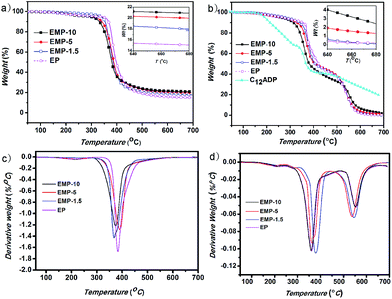 | ||
| Fig. 2 Impact of C12ADP loading on the thermal stability of EP/C12ADP composites in nitrogen (a and c) and air atmosphere (b and d). | ||
The flame retardancy of EP/C12ADP composites was evaluated by cone calorimetric test, which is regarded more close to real fire scenarios. The curves of heat release rate (HRR) were displayed in Fig. 3. The major combustion parameters including time to ignition (TTI), total heat release (THR), peak of heat release rate (pHRR), mean specific extinction area (SEA) mean mass loss rate (MLR), as well as total smoke production (TSP) data were summarized in Table 1. Improvement in TTI could be observed for EMP-1.5 in comparison with neat EP, suggesting that the addition of a small amount of C12ADP could reduce the ignitability of EP/C12ADP composites. However, the TTI value of composites dropped to close to that of neat EP as the C12ADP loading increased. The tendency of TTI value at different C12ADP loadings could be related to the nature of phosphate and long alkyl amine. In the presence of P and N elements, the as-formed char layer could prevent heat and mass transportation, therefore the ignitability of composites reduced. On the other hand, the aliphatic amine used was unstable against heat, therefore the TTI value of composites compromised as reported in literature for layered organo-silicate filled polymers.17 It is noted that the incorporation of C12ADP into EP led to slightly decreased TSP, which gradually decreased with increasing C12ADP loadings, this might suggest that C12ADP plays a role of smoke suppression agent.
| Sample | TTI (s) | THR (MJ m−2) | pHRR (kW m−2) | MLR (g s−1) | SEA (m2 kg−1) | TSP (m2 m−2) |
|---|---|---|---|---|---|---|
| EP | 55.5 | 92.3 | 1008 | 0.090 | 710 | 26.2 |
| EMP-1.5 | 63.5 | 84.7 | 938 | 0.078 | 865 | 23.2 |
| EMP-5 | 60.0 | 79.1 | 593 | 0.063 | 702 | 21.1 |
| EMP-10 | 56.0 | 83.6 | 366 | 0.054 | 664 | 20.9 |
HRR curves (Fig. 3) clearly show the introduction of C12ADP into EP substrate significantly reduced the pHRR, the decrease in pHRR shows a positive correlation with the C12ADP loading, and is in a good agreement with MLR value shown in Table 1. As the adding amount of C12ADP increased from 1.5 wt% to 10 wt%, the pHRR of corresponding composite reduced by 7.0%, 41.1%, and 63.7%, respectively, which suggests the high efficiency of C12ADP in reducing pHRR. From the above discussion, it is clear that low amount of flame retardant C12ADP could delay the ignition time of EP, reduce the amount of smoke emission, and effectively reduce the heat release rate.
In general, the presence of hydroxyl groups from EP or trace amount of water may catalyze the decomposition of the C12ADP to generate a series of acids, such as phosphoric, metaphosphoric, and polyphosphoric acids, which could catalyze and involve in the formation of protective layer, and the quantity and quality of char layer greatly influences the flame retardant property of materials.28,29 Hence, photography and SEM were used to study the char morphology of samples after limiting oxygen index (LOI) test in macroscopic and microscopic scales, respectively. The LOI value of neat EP was 25.0% while those of the obtained composites with increasing C12ADP loadings increased from 25.0% to 27.5%. Fig. 4 shows the digital photos and SEM images of the char morphology of LOI test samples. From Fig. 4a, it is easy to identify that more char residue was retained as more C12ADP was dispersed in epoxy matrix. The structure of char changed from bend and split one for neat EP to a more compact, stable and rigid ones for EP/C12ADP composites. SEM images in Fig. 4b and c provide more detailed information. Two types of char structures have been observed for EP with and without C12ADP. One is sand-like structure illustrated in Fig. 3b, this is the main structure of char from burned neat EP. The other is foam-like structure illustrated in Fig. 4c, which is generated owing to the incorporation of C12ADP into EP. The foam-like char structure is typical for intumescent flame retardant polymer30 and could hinder the transportation of oxygen and heat so that the combustion reflection could be inhibited.
Finally, we assessed the influence of C12ADP loading on the impact toughness of EP/C12ADP composites, the un-notched Charpy impact test was performed and the experimental results were illustrated in Fig. 5. In comparison with the impact toughness of neat EP, composites of EPM-1.5 and EPM-5 showed 17.8% and 25.1% increase in impact toughness, respectively. However, as the loading of C12ADP increased further to 10 wt%, the impact toughness did not improve further. The reason could be: low amount of C12ADP could be easily dispersed in EP and resulted in the improvement of the impact toughness of composites, however, high C12ADP content may lead to the stack of C12ADP layers that would cause a sharp increasing stress and lower the energy for cracks to bypass the obstructions under external stress.31
The fractographic analysis of the fractured surfaces after un-notched Charpy impact test was performed to have a better understanding on the improvement in impact toughness by adding C12ADP into EP (see Fig. 5b and c). The fractured surface of neat EP is smooth and without any sign of deformation (see Fig. 5b), showing a typical brittle fracture. By introducing 5 wt% C12ADP into EP, the fractured surface (see Fig. 5c) became rougher and the channel of crack propagation deflected, which accounts to the improved impact toughness.32 The effective improvement of impact toughness could be mainly attributed to two issues: (1) the rigid inorganic sheets in C12ADP acting like nail and hindering the pathway of crack propagation, (2) the flexible alkyl chains in C12ADP consuming and absorbing the impact energy. However, it is worth of further analysis on the effect of C12ADP on epoxy curing process (kinetics and thermodynamics) and the mechanical properties to elucidate acting fracture failure mechanism.
In conclusion, organic/inorganic intercalated alkyl-ammonium (di)hydrogen phosphates containing phosphorus, nitrogen, and flexible alkyl chain were synthesized in one-pot. Introducing 5 wt% C12ADP into EP achieved composites with 20% increase in impact toughness compared with neat EP. Additionally, the introduction of C12ADP into EP delayed the ignition time and effectively reduced the heat release rate, total heat release, as well as total smoke release. It suggests that C12ADP as a single-component additive could simultaneously enhance the flame retardancy and impact toughness of EP at low loadings. Further study on the effect of C12ADP on the curing process (kinetics and thermodynamics), as well as the acting flame retardant mechanism, will be performed to deepen the understanding of the role of C12ADP.
Acknowledgements
The authors would like to thank Mr C. Xie for LOI measurements, Mr B.-B. Xu for TEM measurements, Prof. Dr L.-Z. Dai, Prof. Dr J.-X. Mi and Dr D.-H. Li for valuable discussion, as well as Dr G. Aufermann and Ms A. Völzke at MPI CPfS in Dresden of Germany for elemental analyses. This work was supported by the Natural Science Foundation of Fujian Province of China (No. 2010J0130, No. 2014J06021), Scientific and Technological Innovation Platform of Fujian Province of China (2014H2006), and the National Natural Science Foundation of China (No. 21201144 and 21233004).Notes and references
- “Epoxy polymers: new materials and innovations”, ed. J. P. Pascault and R. J. J. Williams, Wiley-VCH, Mörlenbach, 2012 Search PubMed.
- S. Lv, Y. Yuan and W. Shi, Prog. Org. Coat., 2009, 65, 425 CrossRef CAS.
- R. M. Perez, J. K. W. Sandler, V. Altstädt, T. Hoffmann, D. Pospiech and M. Ciesielski, et al., Polymer, 2007, 48, 778 CrossRef CAS.
- M. Alaee, P. Arias, A. Sjödin and Å. Bergman, Environ. Int., 2003, 29, 683 CrossRef CAS PubMed.
- J. Wu, Y. Zhang, X. Luo, Y. She, L. Yu and S. Chen, et al., Environ. Sci., 2012, 24, 183 CAS.
- C. Li and Y. Z. Wang, Polym. Adv. Technol., 2010, 21, 1 Search PubMed.
- H. D. Lu, L. Song and Y. Hu, Polym. Adv. Technol., 2011, 22, 379 CrossRef CAS.
- Y. L. Shui and I. Hamerton, Progr. Polym. Sci., 2002, 27, 1661 CrossRef.
- S. Liu, H. Q. Yan, Z. P. Fang, Z. H. Guo and H. Wang, RSC Adv., 2014, 4, 18652 RSC.
- H. T. Lin, C. H. Lin, Y. M. Hu and W. C. Su, Polymer, 2009, 50, 5685 CrossRef CAS.
- L. Chen, L. Song, P. Lv, G. Jie, Q. Tai and W. Xing, et al., Prog. Org. Coat., 2011, 70, 59 CrossRef CAS.
- N. N. Tian, J. Gong, X. Wen, K. Yao and T. Tang, RSC Adv., 2014, 4, 17607 RSC.
- C. L. Chiang and R. C. Chang, Compos. Sci. Technol., 2008, 68, 2849 CrossRef CAS.
- C. Zhe and B. J. Qu, Chin. J. Polym. Sci., 2010, 28, 563 CrossRef.
- L. Liu, Y. A. Zhang, L. Li and Z. Z. Wang, Polym. Adv. Technol., 2011, 22, 2403 CrossRef CAS.
- O. Becker, R. Varley and G. Simon, Polymer, 2002, 43, 4365 CrossRef CAS.
- C. Zilg, R. Mülhaupt and J. Finter, Macromol. Chem. Phys., 1999, 200, 661 CrossRef CAS.
- D. Y. Wang, Y. Liu, X. G. Ge, Y. Z. Wang, A. Stec and B. Biswas, et al., Polym. Degrad. Stab., 2008, 93, 1024 CrossRef CAS.
- E. N. Kalali, X. Wang and D. Y. Wang, J. Mater. Chem. A, 2015, 3, 6819–6826 CAS.
- C. Li, J. T. Wan, E. Kalali, H. Fan and D. Y. Wang, J. Mater. Chem. A, 2015, 3, 3471–3479 CAS.
- D. Y. Wang, X. Q. Liu, J. S. Wang, Y. Z. Wang, A. A. Stec and T. R. Hull, Polym. Degrad. Stab., 2009, 4, 544 CrossRef.
- H. J. Sue, K. T. Gam, N. Bestaoui, N. Spurr and A. Clearfield, Chem. Mater., 2003, 16, 242 CrossRef.
- S. R. J. Oliver, A. J. Lough and G. A. Ozin, Inorg. Chem., 1998, 37, 5021 CrossRef CAS PubMed.
- S. Chen, H. Borrmann, Y. X. Huang, Z. J. Zhang, H. H. Chen and J. T. Zhao, Langmuir, 2008, 24, 9323 CrossRef CAS PubMed.
- B. Youssef, L. Lecamp, W. El Khatib, C. Bunel and B. Mortaigne, Macromol. Chem. Phys., 2003, 204, 1842 CrossRef CAS.
- S. Zhu and W. Shi, Polym. Degrad. Stab., 2003, 80, 217 CrossRef CAS.
- D. Sun and Y. Yao, Polym. Degrad. Stab., 2011, 96, 1720 CrossRef CAS.
- W. Zhang, X. Li and R. Yang, Polym. Degrad. Stab., 2011, 96, 2167 CrossRef CAS.
- J. Feng, J. Hao, J. Du and R. Yang, Polym. Degrad. Stab., 2012, 97, 605 CrossRef CAS.
- X. Wu, L. Wang, C. Wu, J. Yu, L. Xie and G. Wang, et al., Polym. Degrad. Stab., 2012, 97, 54 CrossRef CAS.
- L. J. Chen, L. Song, P. Lv, G. X. Jie, Q. L. Tai and W. Y. Xing, et al., Prog. Org. Coat., 2011, 70, 59 CrossRef CAS.
- G. Yang, S. Y. Fu and J. P. Yang, Polymer, 2007, 48, 302 CrossRef CAS.
Footnote |
| † Electronic supplementary information (ESI) available: Details of the sample preparation and characterization techniques used. Fig. S1: small-angle powder XRD patterns of synthesized epoxy modifiers. Fig. S2: powder XRD patterns of modified epoxy composites in comparison with that of epoxy modifier. See DOI: 10.1039/c5ra18358h |
| This journal is © The Royal Society of Chemistry 2015 |

